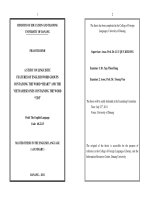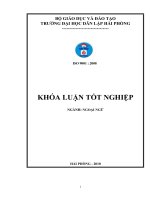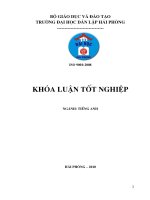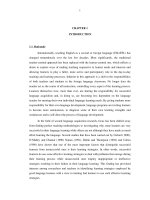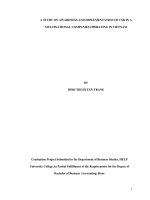A study on subjuntive and errors made by vietnamese learners
Bạn đang xem bản rút gọn của tài liệu. Xem và tải ngay bản đầy đủ của tài liệu tại đây (434.55 KB, 59 trang )
BỘ GIÁO DỤC VÀ ĐÀO TẠO
TRƯỜNG ĐẠI HỌC DÂN LẬP HẢI PHỊNG
-------------------------------
ISO 9001 : 2008
KHĨA LUẬN TỐT NGHIỆP
NGÀNH: NGOẠI NGỮ
HẢI PHÒNG - 2010
1
HAIPHONG PRIVATE UNIVESITY
FOREIGN LANGUAGES DEPARTMENT
-----------------------------------
GRADUATION PAFER
A STUDY ON SUBJUNCTIVE AND ERRORS MADE
BY VIETNAMESE LEARNERS
By:
Phạm Thị Linh
Class:
NA 1001
Supervisor:
Phạm Thị Thu Hằng, M.A
HAI PHONG – 2010
2
BỘ GIÁO DỤC VÀ ĐÀO TẠO
TRƯỜNG ĐẠI HỌC DÂN LẬP HẢI PHÒNG
--------------------------------------
Nhiệm vụ đề tài tốt nghiệp
Sinh viên:
Phạm Thị Linh
Mã số:
101330
Lớp : NA1001
Ngành: Ngoại Ngữ
Tên đề tài : A study on Subjunctive Mood and some errors made by
Vietnamese learners
3
Nhiệm vụ đề tài
1. Nội dung và các yêu cầu cần giải quyết trong nhiệm vụ đề tài tốt
nghiệp ( về lý luận, thực tiễn, các số liệu cần tính toán và các bản vẽ).
……………………………………………………………………………..
……………………………………………………………………………..
……………………………………………………………………………..
……………………………………………………………………………..
……………………………………………………………………………..
……………………………………………………………………………..
……………………………………………………………………………..
2. Các số liệu cần thiết để thiết kế, tính tốn.
……………………………………………………………………………..
……………………………………………………………………………..
……………………………………………………………………………..
……………………………………………………………………………..
……………………………………………………………………………..
……………………………………………………………………………..
……………………………………………………………………………..
……………………………………………………………………………..
3. Địa điểm thực tập tốt nghiệp.
……………………………………………………………………………..
……………………………………………………………………………..
……………………………………………………………………………..
4
CÁN BỘ HƯỚNG DẪN ĐỀ TÀI
Người hướng dẫn thứ nhất:
Họ và tên:.............................................................................................
Học hàm, học vị:...................................................................................
Cơ quan công tác:.................................................................................
Nội dung hướng dẫn:............................................................................
Người hướng dẫn thứ hai:
Họ và tên:.............................................................................................
Học hàm, học vị:...................................................................................
Cơ quan công tác:.................................................................................
Nội dung hướng dẫn:............................................................................
Đề tài tốt nghiệp được giao ngày 12 tháng 04 năm 2010
Yêu cầu phải hoàn thành xong trước ngày 10 tháng 07 năm 2010
Đã nhận nhiệm vụ ĐTTN
Đã giao nhiệm vụ ĐTTN
Người hướng dẫn
Sinh viên
Hải Phòng, ngày
tháng
năm 2010
HIỆU TRƯỞNG
GS.TS.NGƯT Trần Hữu Nghị
5
PHẦN NHẬN XÉT TÓM TẮT CỦA CÁN BỘ HƯỚNG DẪN
1. Tinh thần thái độ của sinh viên trong quá trình làm đề tài tốt
nghiệp:
……………………………………………………………………………..
……………………………………………………………………………..
……………………………………………………………………………..
……………………………………………………………………………..
……………………………………………………………………………..
……………………………………………………………………………..
2. Đánh giá chất lượng của khóa luận (so với nội dung yêu cầu đã đề ra
trong nhiệm vụ Đ.T. T.N trên các mặt lý luận, thực tiễn, tính tốn số
liệu…):
……………………………………………………………………………..
……………………………………………………………………………..
……………………………………………………………………………..
……………………………………………………………………………..
……………………………………………………………………………..
……………………………………………………………………………..
3. Cho điểm của cán bộ hướng dẫn (ghi bằng cả số và chữ):
……………………………………………………………………………..
……………………………………………………………………………..
……………………………………………………………………………..
Hải Phòng, ngày ….. tháng ..… năm 2010
Cán bộ hướng dẫn
(họ tên và chữ ký)
6
NHẬN XÉT ĐÁNH GIÁ
CỦA NGƯỜI CHẤM PHẢN BIỆN ĐỀ TÀI TỐT NGHIỆP
1. Đánh giá chất lượng đề tài tốt nghiệp về các mặt thu thập và phân tích tài
liệu, số liệu ban đầu, giá trị lí luận và thực tiễn của đề tài.
2. Cho điểm của người chấm phản biện :
(Điểm ghi bằng số và chữ)
Ngày.......... tháng......... năm 2010
Người chấm phản biện
ACKNOWLEDGEMENTS
7
Firstly, I would like to give my deepest thanks to all teachers in Foreign
Language Department for their help and advice. I am extremely grateful to
my supervisor – Ms Pham Thi Thu Hang who always guided and encouraged
me during the time I did my research. Furthermore, she also gave me her
documents and knowledge to complete this paper. I am sure that my
graduation paper will not be succeeded without her help and correction.
Secondly, I also thank all members in my family. They are always
beside me, enthuse and support me.
Finally, my thanks are given to my friends who gave me some good
ideas and information to do this research. I truthfully appreciate all their help
and encouragement.
Hai Phong, June 2010.
Pham Thi Linh
TABLE OF CONTENTS
PART II: INTRODUCTION............................................................................. 1
8
I – Rationale ................................................................................................. 12
II – Aims of the study .................................................................................. 12
III – Methods of the study ........................................................................... 13
IV – Scope of the study ............................................................................... 13
V – Design of the study ............................................................................... 13
PART II: DEVELOPMENT ........................................................................... 15
Chapter I: An over view on mood ............................................................... 15
1. Definitions of mood........................................................................... 15
2. Kinds of mood ................................................................................... 15
2.1. The indicative mood ...................................................................... 15
2.2. The imperative mood ..................................................................... 16
2.3. The subjunctive mood .................................................................... 18
Chapter II: Theoretical background of subjunctive mood ........................... 19
1. Definitions of subjunctive mood ...................................................... 19
2. Kinds of subjunctive mood .............................................................. 19
2.1. The present subjunctive mood .................................................. 20
2.1.1. The present subjunctive mood expresses a wish, a prayer, a
hope or a cause…. in certain fixed phrases................................... 21
2.1.2. The present subjunctive mood in object clauses ................ 22
2.1.2.1. The present subjunctive mood is used in object clause after
verbs and word-groups ................................................................... 22
2.1.2.2. The present subjunctive mood is also used in object
clauses after impersonal expressions with the same meaning as the
above verbs .................................................................................... 23
2.1.2.3. The present subjunctive mood is used when the subject of
the principal clause is expressed by an abstract noun such as wish,
suggestion, aim, idea … ............................................................... 25
2.1.3. Occasionally, the present subjunctive mood is used in some
adverbial clauses .............................................................................. 25
2.1.3.1. The present subjunctive mood is used in adverbial clauses
of concession or condition (to express a doubt)........................... 25
2.1.3.2. The present subjunctive mood is used in adverbial clauses
of time and place after conjunctions “whenever” and “wherever”
........................................................................................................ 26
2.1.3.3. The present subjunctive mood is also used in adverbial
clauses of purpose ........................................................................ 26
9
2.1.4. The present subjunctive mood is used in inversion of first
conditional sentences ....................................................................... 27
2.2. The past subjunctive mood ........................................................ 27
2.2.1. The past subjunctive mood is used in conditional clauses
implying a negative or in clauses in which the condition is
combined with reality ...................................................................... 28
2.2.1.1. The past subjunctive mood is used in second conditional
sentences ........................................................................................ 28
2.2.1.2. The past subjunctive mood is also used in mixed
conditional type. ........................................................................... 29
2.2.1.3. The past subjunctive mood is used in inversion of second
conditional sentences ................................................................... 30
2.2.1.4. The conjunctions introducing adverbial clauses of
condition are: if, in case, provided, suppose, and some others ... 30
2.2.2. The past subjunctive mood is used in object clauses when the
predicate of the principal clause is expressed by “wish”/ “If only”
........................................................................................................... 31
2.2.3. The past subjunctive mood is used in adverbial clauses of
comparison (or manner) introduced by the conjunctions as if / as
though ............................................................................................... 32
2.2.4. The past subjunctive mood is also used in attributive clauses
modifying the noun time in the principal clause “It is time” or “It is
high time” ......................................................................................... 33
2.2.5. Sentences staring with “would rather” indicate one‟s
preferences and are also expressed in past subjunctive mood........ 34
2.3. Past perfect subjunctive mood .................................................. 35
2.3.1. The past perfect subjunctive is mainly used in the third
condition ........................................................................................... 36
2.3.2. The past perfect subjunctive mood expresses an unreal fact or
unreal event in the past ................................................................... 37
2.3.2.1. The past perfect subjunctive mood is used in adverbial
clauses of concession with conjunctions and connectives: though,
although, however, no matter, whatever, whoever… ............... 37
2.3.2.2. The past perfect subjunctive mood is used in adverbial of
comparison (or manner) introduced by the conjunctions: as if/ as
though ............................................................................................ 37
2.3.2.3. The past perfect subjunctive mood is also used in object
clauses when the predicate of the principal clause is expressed by
“wish”/ “If only” .......................................................................... 38
10
3. Passive forms of subjunctive mood ................................................ 38
3.1. Use of the present forms of the subjunctive mood .................. 39
3.2. Use of the past forms of the subjunctive mood........................ 40
Chapter III: Some errors of subjunctive mood made by ............................. 41
1. Recognizing the subjunctive mood ................................................ 41
2. The verbs form in the subjunctive mood ...................................... 42
2.1. In present subjunctive mood clause ......................................... 42
2.1.1. In some certain fixed expressions........................................ 42
2.1.2. In an object clause................................................................. 43
2.2. In the past and past perfect subjunctive mood ....................... 45
2.2.1. In the second type conditional ............................................. 45
2.2.2. In clause beginning with “If only” and “Only if” ................ 46
2.2.3. In clauses with conjunctions “as if”/“as though” ................ 48
2.2.4. In clause after “would rather” ............................................. 48
CHAPTER IV: SOME SUGGESTED SOLUTIONS ................................. 50
PART III: CONCLUSION .............................................................................. 51
1. Summary of the study......................................................................... 51
2. Suggestion for further study .............................................................. 51
APPENDIX ..................................................................................................... 53
The suggested key ........................................................................................... 56
REFERENCES ................................................................................................ 58
PART II: INTRODUCTION
11
I – Rationale
There are so many spoken languages all over the world, but English
language is the most popular and common. More than billions of people are
speaking and using English language everyday in their life. So, English plays
an important role in our modern life because it is one of the vital demands of
almost English learners.
However, it is not easy for learners to get success in learning English
because of many diffculties in its grammar, vocabulary and pronunciation…
Grammar is one of the most difficult part which English learners usually meet
and make mistakes. In English grammar, mood is a small and special part.
Although mood is not used as much as other parts, for instance: verb tense,
sentences or passive…, it is also important for English learners to get.
People often use Mood in normal dialogues and communication. In the
process of using mood, they rarely use subjunctive mood – one kind of mood
and sometimes make some unnecessary mistakes because they are not
common and difficult. Moreover, subjunctive mood is very interesting and
attractive.Those reasons make me try to study more on subjunctive mood. I
hope that my study is useful for every English learner to understand more
about subjunctive mood and avoid making mistakes in using it.
II – Aims of the study
My study is aimed at:
- Introducing definitions and kinds of mood.
- Showing definitions and kinds of subjunctive mood.
- Detecting how every kind of subjunctive mood is.
- Analyzing some errors made by Vietnamese learners.
- Mentioning some suggested solutions for the errors.
12
III – Methods of the study
I got many examples and definitions from reference books and websites
which related to my study: „A study on subjunctive mood and some errors
made by Vietnamese learners‟. Those make my study richer and more
attractive.
After collecting information from varied sources of materials, I used
interpretative analysis to get the main points for the theories of my topic.
Then, in the next step of seeking errors made by Vietnamese learners, I
carried out survey exercises to confirm my hypothesis of the matter.
Furthermore, with the students at Hai Phong Private University, I got
some advice and correction from my supervisor who guided me to finish this
graduation paper. I also received my friends‟ document which they selected
from their source of books.
These are methods I did my research.
IV – Scope of the study
Because of the limitation of time and the range of study, I just concentrate
on subjunctive mood – one kind of mood, and some errors made by
Vietnamese learners, and how to solve these errors.
Due to lack of knowledge and experienece, my graduation paper surely
makes some mistakes. So, I am highly appreciated your correction and
recommendations. They are very useful for me to complete this research.
V – Design of the study
My study contains three main parts:
13
Part I – Introduction that consists of rationale, aims, methods, scope and
design of the study.
Part II – Development – the main of the study – is divided into four
chapters :
Chapter I is an over view on mood.
Chapter II is the theoretical background of subjunctive mood.
Chapter III talks about some errors of subjunctive mood made by
Vietnamese learners.
Chapter IV is some suggested solution for the errors.
Part III – Conclusion that gives reviews, limitation and some suggestions for
the study.
Appendix
References
14
PART II: DEVELOPMENT
Chapter I: An over view on mood
1. Definitions of mood
There are some definitions of mood :
Mood shows the attitude of the speaker or the writer to the action or state
described by the verb.
By />Mood is a characteristic of verbs that involves the speaker‟s attitude toward
the action expressed.
By />Mood of a verb expressing wishes, stipulating demands, or making statements
contrary to fact…
By />In grammar, Mood is category that reflects the speaker‟s view of an event‟s
reality, likelyhood or urgency.
By />
2. Kinds of mood
In Enlish, mood includes in three types. They are indicative mood,
imperative mood and sunjunctive mood.
2.1. The indicative mood
The indicative mood is the verb used in ordinary statements and pose
question. It is regarded as a factual or neutral situations, as something which
has occurred or is occurring at the moment of speaking or will occur in the
future. It may denote actions with different time-reference and different
15
aspective characteristics. Therefore the Indecative Mood has a wide variety of
tense and aspect forms in the active and passive voice.
By />The indicative mood has three forms : the affirmative, the nagative, and
the interrogative.
E.g.
-
She went home late yesterday.
-
Has he called her yet ?
-
I do not want to go out with him.
- The cat was bitten by the dog.
2.2. The imperative mood
The imperative mood expresses a command or a request to perform an
action addressed to somebody, but not the action itself. As it does not actually
denote a specific action it has no tense category ; the action always refers to
the future.
By />The imperative mood is used to give orders and instructions :
E.g.
- Go home!
- Come and see me!
- Forget it!
- Come here !
- Sit down !
- Don‟t be a fool !
( />16
Notice that there is no subject in these imperative sentences. The pronoun
you (singular or plural, depending on context) is the "understood subject" in
imperative sentences. Virtually all imperative sentences, then, have a second
person (singular or plural) subject.
In commands and requests addressed to a third person or persons, the
analytical form let… + infinitive is used. The sole exception is the first
person construction, which includes an objective form as subject: "Let's (or
Let us)”. When the person addressed is denoted by a personal pronoun, it is
used in the objective case.
The analytical forms difeer in meaning from the synthetic forms, because
their meaning is closely connected with the meaning of the pronoun included
un the form. Thus, let us do smth denotes an invitation or a joint action, not
an order or a request.
By />
E.g.
- Let us go together!
- Let him finish his dinner first.
- Let‟s go to the cinema.
( />In negative sentences, the alalytical forms take the particle not after Let,
without an auxiliary.
E.g.
- Let us not argue on the matter.
- Let her not go any further.
- Let him not know the truth.
- Let him not overtestimate his chances.
( />17
The imperative mood is used only in imperative sentences and cannot be
used in questions.
2.3. The subjunctive mood
The subjunctive mood shows that the action or state expressed by the verb
is presented as doubts, possibility, wishes, desire or anything else contrary to
fact.
The subjunctive mood has synthetic and anlytical attitude of the speaker
to real fact. It is not used much on English any more and exists in a few
phrases.
By />
E.g.
- I wish I were ten years younger.
- If you taught me, I would learn quickly.[(Quirk, (1973 :50)]
- If only he did not smoke! [Thomson and Martinet, (1986 :204)]
- It is neccessary that you learn by heart this lesson now.
- God save the Queen! [Quirk, (1973 :50)]
18
Chapter II: Theoretical background of subjunctive mood
1. Definitions of subjunctive mood
In many reference books or websites, the definitions of subjunctive mood
have the same meaning.
These are some definitions of subjunctive mood:
The Subjunctive Mood is used not to indicate that something is being asserted
but that it is contrary to fact, supposed, doubted, feared or desired.
By />The Subjunctive Mood is the mood of a verb used to show hopes, doubts,
wishes….
By />
The subjunctive mood is used more in writing than in speech. It is not
used very much in modern British English. The synthetic forms of the
subjunctive mood can be traced to the Old English period, when the
subjunctive mood was chiefly expressed by synthetic forms. In Old English,
the subjunctive mood had a special set of inflections, different from those of
the indicative mood.
By />“The old subjunctive is disappearing as language usage becomes modified
and simplified. Current business usage recognizes it only as a wish mood."
[Val Dumond, (1993) Grammar for Grownups, HarperCollins]
2. Kinds of subjunctive mood
19
The subjunctive mood is divided in three types. They are present
subjunctive mood, past subjunctive mood and past perfect subjunctive mood.
To study more about every kind of subjunctive mood, we together study
on it carefully.
2.1. The present subjunctive mood
In the present subjunctive mood, the verb to be has the form be for all the
persons - singular and plural, which differs from the corresponding forms of
the indicative mood (the present indefinite). Sentences in which normally
have used the verbs: “is”, “are”, “was”, “were” or “will be” should have the
root word “be” if they are used in the present subjunctive mood.
In all other verbs, the forms of the present subjunctive mood differ from
the corresponding forms of the indicative mood only in the third person
singular, which in the present subjunctive has no ending –s.
[Thomson and Martinet, (1986:253)]
E.g.
- The Queen lives here. (simple present tense)
-
Long live the queen! (present subjunctive)
The present subjunctive denotes an action referring to the present or
future. This form is but seldom used in Modern English. It may be found in
poetry and in elevated prose, where these forms are archaisms used with a
certain stylistic aim. It is also used in scientific language and in the language
of official documents, where it is a living form.
There are four ways in which sentences are formed in the present
subjunctive mood:
20
